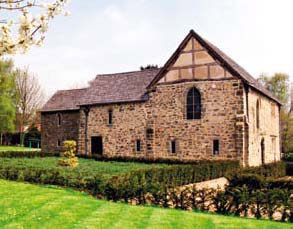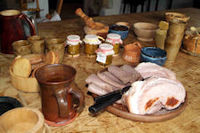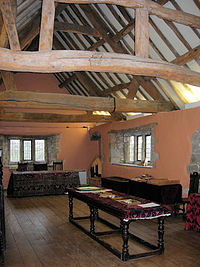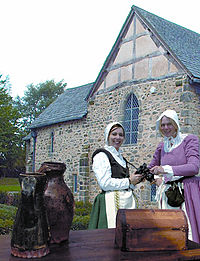Donington le Heath Manor House
Donington le Heath Manor House is a rare surviving example of a manor house built around seven hundred years ago in Donington le Heath in Leicestershire, near a town which grew up long after the house was built - Coalville,.
The house was once owned by a relative of one of the Gunpowder plotters, and is now managed by the council and opened as a museum.
History
The museum is based in a mediæval manor house, believed to date back to 1280. From the style of the architecture of the parts of the building and from tree-ring dating of some of the timbers still present, the present house at Donington was probably built between 1288 and 1295.
Some of the features of the house along with tree-ring dating of the timbers in the roof show that the Manor House was heavily modernised around 1618. It appears that at this time, the downstairs storerooms were converted into a kitchen and a parlour. A new roof was put on and the rooms upstairs were remodelled with a new internal staircase. Externally, the most obvious addition from this period are the large rectangular mullioned windows. At this time, the house was probably owned by John Digby, whose elder brother, Everard Digby was a close friend of Guy Fawkes and was executed in 1606 for his part in the Gunpowder Plot.
From 1670 to 1960, the house was rented out as a tenant farm. The council bought the Manor House in 1965 to preserve the building for future generations. The Manor House was opened as a museum in 1973.
Gunpowder Plot
Donington le Heath Manor House was owned, during the 15th and 16th Century, by the Digby family.
In 1485 Sir John Digby fought at the Battle of Bosworth for Henry Tudor Earl of Richmond. Henry was victorious and Richard slain, and the new King Henry VII returned to the Digbys the lands had lost in 1462 for their opposition to the Yorkist kings.
During 1574, the property was owned by Everard Digby. Everard was a close friend of Guy Fawkes and he was executed in 1606 for being one of the Gunpowder Plotters.
Museum
Visitors to the Manor House can see restored rooms and displays on mediæval life as well as a series of temporary exhibitions on a wide range of subjects. The house is set in recently recreated 17th century style gardens with flower gardens, an orchard, herb gardens and a maze.
The museum also has an experienced education team who offer a wide range of workshop and outreach sessions for children.
The Manor House is noted for its lively series of monthly events that use re-enactment, crafts, hands-on activities and specialist demonstrations to interpret Leicestershire's history and archaeology to visitors of all ages.
The Museum also houses the stone barn Classics Tea Room, which serves home made cakes, light meals and refreshments.
Events
Events at the museum include:
- Apple Day (October) The annual celebration of the English apple. Games, craft, tastings and juice making to try.
- Gunpowder, Treason and Plot (November) Learn about the Gunpowder Plot in a house owned by Sir Everard Digby, one of the Gunpowder Plotters: demonstrations of gunpowder, living history displays, scenarios, children's crafts and more.
- Regular Mediæval Banquets at the Classics Tea Room (throughout the year).
Friends
The Friends organisation for Donington exists to support the museum's further development through fundraising, help with events and guided tours and to help research the history of the Manor House building and its locality. The Friends of Donington le Heath Manor House is a registered charity.[1]
Outside links
- Location map: 52.7100611 -1.3796528
- Donington Manor House Museum
- Friends of Donington le Heath Manor House
- Leicestershire Museums Blog
References
- Leicestershire County Council historical records
- McLoughlin, V. (1999) Donington le Heath Manor House and its Connection with the Families of Donington and Hugglescote. Produced for the Friends of Donington le Heath, 1999 and 2000.
- Nichols, John (1811) The History and Antiquities of the County of Leicester



